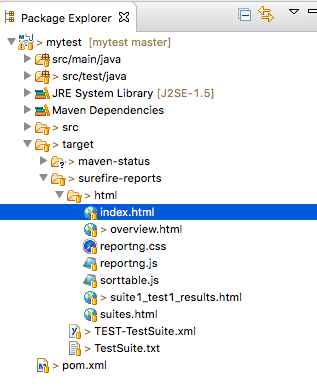一直在用的webUI自动化测试框架,以前写得太粗糙了,现在细化一下。
weiUI自动化测试需要掌握以下几点:一是获取元素,java获取元素对象与python差不多,用的是findElement方法,不过我在搭建框架过程中为了实现PO模式,从万能的百度中获知还有个一更好的类FindBy,FindBy+PageFactory可以完美实现PO模式。二是测试框架,junit和testNG都是java方面的主流测试框架,这两个框架我都没有用过,不能比较二者优劣,不过看现在各公司的招聘要求基本都是写着要会testNG,所以选择testNG作为测试框架应该不会错。三是测试报告的展示,尝试过后,发现测试报告还是reportNG比testNG的原生测试报告好看,所以决定用reportNG代替testNG生成测试报告。最后就是项目的构建了,很久以前我也是用过maven的,觉得这个东西还是满好用的,所以框架中也加上吧。下面就一个个说一下我的代码结构。
以下是配置文件POM.xml,各依赖关系下面已经注析清楚。
<project xmlns="http://maven.apache.org/POM/4.0.0" xmlns:xsi="http://www.w3.org/2001/XMLSchema-instance" xsi:schemaLocation="http://maven.apache.org/POM/4.0.0 http://maven.apache.org/xsd/maven-4.0.0.xsd"> <modelVersion>4.0.0</modelVersion> <groupId>myTest</groupId> <artifactId>mytest</artifactId> <version>0.0.1-SNAPSHOT</version> <packaging>jar</packaging> <name>mytest</name> <url>http://maven.apache.org</url> <properties> <project.build.sourceEncoding>UTF-8</project.build.sourceEncoding> </properties> <dependencies> <dependency> <groupId>org.testng</groupId> <artifactId>testng</artifactId> <version>6.14.2</version> <scope>test</scope> </dependency> <!-- 加入reportNG依赖,代替testNG测试报告 --> <dependency> <groupId>org.uncommons</groupId> <artifactId>reportng</artifactId> <version>1.1.4</version> <scope>test</scope> <exclusions> <exclusion> <groupId>org.testng</groupId> <artifactId>testng</artifactId> </exclusion> </exclusions> </dependency> <!-- 加入selenium做webUI测试,选用selenium2 --> <dependency> <groupId>org.seleniumhq.selenium</groupId> <artifactId>selenium-java</artifactId> <version>2.53.1</version> </dependency> <!-- 依赖Guice --> <dependency> <groupId>com.google.inject</groupId> <artifactId>guice</artifactId> <version>3.0</version> <scope>test</scope> </dependency> </dependencies> <build> <plugins> <!-- 加入maven-surefire-plugin插件用来使用maven执行用例,其中suiteXmlFile配置的就是testNG用例执行文件的地址 --> <plugin> <groupId>org.apache.maven.plugins</groupId> <artifactId>maven-surefire-plugin</artifactId> <version>2.21.0</version> <configuration> <suiteXmlFiles> <suiteXmlFile>src/test/java/myTest/mytest/testNG.xml</suiteXmlFile> </suiteXmlFiles> <!-- 加入编码设置,否则生成的报告会中文乱码 --> <argLine>-Dfile.encoding=UTF-8</argLine> </configuration> </plugin> <!-- 添加插件,添加ReportNg的监听器,修改最后的TestNg的报告 --> <plugin> <groupId>org.apache.maven.plugins</groupId> <artifactId>maven-surefire-plugin</artifactId> <version>2.5</version> <configuration> <properties> <property> <name>usedefaultlisteners</name> <value>false</value> </property> <property> <name>listener</name> <value>org.uncommons.reportng.HTMLReporter</value> </property> </properties> <workingDirectory>target/</workingDirectory> <!-- <forkMode>always</forkMode> --> </configuration> </plugin> </plugins> </build> </project>
接下来是代码实现,根据以往经验,UI自动化测试很容易出现找到不对象的情况,所以在操作之前必须判断对象是否存在,java和python一样有隐式等待和显式等待,我选择使用更加稳妥的显式等待。Java显式等待使用的是WebDriverWait+ExpectedConditions,使用方式如下:
|
new WebDriverWait(driver,10).until( ExpectedConditions.presenceOfElementLocated(By.cssSelector("css locator"))); |
也就是说要在定位元素的时候加入这两个类作为等待条件,直到目标元素出现为止。但是如果每一个元素都这么写的话就有很多冗余代码了,所以我写了个公共类BasePage.java,重写了click事件和sendkeys事件,代码如下:
/** * @author:Helen * @date:2018年4月7日 * @Description: 处理页面元素公共类,重写页面操作事件,为每个元素加入显式等待 */ package myTest.mytest; import org.openqa.selenium.WebDriver; import org.openqa.selenium.WebElement; import org.openqa.selenium.support.ui.ExpectedConditions; import org.openqa.selenium.support.ui.WebDriverWait; public class BasePage { WebDriver driver; private final int timeOut = 10;//等待时间 public BasePage(WebDriver driver) { // TODO Auto-generated constructor stub this.driver = driver; } /* 重写senkeys方法 */ void sendkeys(WebElement element, String s) { new WebDriverWait(driver, timeOut).until(ExpectedConditions.visibilityOf(element));// 加入显式等待 element.clear();// 先清空输入框 element.sendKeys(s);// 输入数据 } /* 重写click方法 */ void click(WebElement element) { new WebDriverWait(driver, timeOut).until(ExpectedConditions.visibilityOf(element));// 加入显式等待 element.click(); } }
接下来就是实现页面对象获取了,下面以百度页面为示例
/** * @author:Helen * @date:2018年4月7日 * @Description: 百度页面,对象定位和操作,继承BasePage */ package myTest.mytest; import org.openqa.selenium.WebDriver; import org.openqa.selenium.WebElement; import org.openqa.selenium.support.FindBy; public class MyPage extends BasePage{ public MyPage(WebDriver driver) { super(driver); // TODO Auto-generated constructor stub } //关键词输入框 @FindBy(id="kw") private WebElement kw_Element; //“搜索”按钮 @FindBy(id="su") private WebElement su_Element; //输入关键词 public void kw_sendkes(String s){ this.sendkeys(kw_Element, s); } //点击“搜索”按钮 public void su_click() { this.click(su_Element); } }
接下来是写测试业务内容,加载页面的时候加入PageFactory,代码如下:
/** * @author:Helen * @date:2018年4月7日 * @Description: 百度搜索测试 */ package myTest.mytest; import org.testng.annotations.AfterMethod; import org.testng.annotations.Test; import org.testng.Assert; import org.openqa.selenium.WebDriver; import org.openqa.selenium.firefox.FirefoxDriver; import org.openqa.selenium.support.PageFactory; public class myTestNg { private WebDriver driver = new FirefoxDriver(); @Test public void baidu_search() { MyPage myPage = PageFactory.initElements(driver, MyPage.class); driver.get("https://www.baidu.com"); driver.manage().window().maximize();//窗口最大化 myPage.kw_sendkes("helenMemery"); myPage.su_click(); } @Test public void f2() { Assert.assertEquals("b", "b"); } @AfterMethod public void close(){ //driver.close(); } }
最后是配置testNG.xml文件,内容如下:
<?xml version="1.0" encoding="UTF-8"?> <!DOCTYPE suite SYSTEM "http://testng.org/testng-1.0.dtd"> <suite name="百度搜索"> <test name="搜索业务"> <classes> <class name="myTest.mytest.NewTest"></class> <class name="myTest.mytest.myTestNg"></class> </classes> </test> </suite>
接下来就是执行测试了,选中pom.xml右键-Run As-maven test

最后生成HTML 测试报告,如下图所示:


最后剩下来的就是配置jenkins了,这个以后再写下来吧。